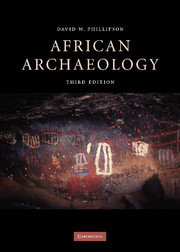Book contents
- Frontmatter
- Contents
- List of illustrations
- Sources of illustrations
- Preface
- 1 Introduction
- 2 The emergence of humankind in Africa
- 3 The consolidation of basic human culture
- 4 Regional diversification and specialisation
- 5 The beginnings of permanent settlement
- 6 Early farmers
- 7 Iron-using peoples before AD 1000
- 8 The second millennium ad in sub-Saharan Africa
- Bibliographic guide
- Bibliographic references
- Index
7 - Iron-using peoples before AD 1000
Published online by Cambridge University Press: 05 June 2012
- Frontmatter
- Contents
- List of illustrations
- Sources of illustrations
- Preface
- 1 Introduction
- 2 The emergence of humankind in Africa
- 3 The consolidation of basic human culture
- 4 Regional diversification and specialisation
- 5 The beginnings of permanent settlement
- 6 Early farmers
- 7 Iron-using peoples before AD 1000
- 8 The second millennium ad in sub-Saharan Africa
- Bibliographic guide
- Bibliographic references
- Index
Summary
Iron
The greater part of Africa differs from most other regions of the Old World in that there was (except in Egypt and some other areas of northern and northeastern Africa) no distinct ‘Bronze Age’ or ‘Copper Age’ during which softer metals, often including gold, were utilised but when techniques of smelting iron had not yet been mastered. In the sub-Saharan latitudes, iron was the first metal to be brought into use; the working of copper and gold began at the same time or somewhat later (van der Merwe 1980; D. Miller 2003). In most of Africa south of the equator, the beginnings of farming and of iron-working took place at approximately the same time. In the latter area there was thus a pronounced contrast between the metal-using farming people and their stone-tool-using hunter-gatherer neighbours and immediate predecessors.
The beginnings of metallurgy cannot be said to have made such a great impact on prehistoric life-styles as did the advent of cultivation and herding. The civilisation of ancient Egypt (pp. 189–95 above) provides a vivid example of the technological achievements that could be attained with virtually no use of iron. Basically, the advantages of iron are ones of increased efficiency. The clearance of forest, the working of wood, the quarrying and carving of stone, the cultivation of ground and the slaughter of enemies may all be accomplished more effectively and with less effort by people who are equipped with iron tools and weapons.
- Type
- Chapter
- Information
- African Archaeology , pp. 214 - 273Publisher: Cambridge University PressPrint publication year: 2005



